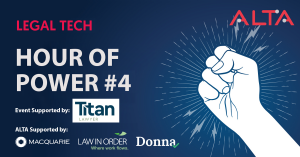Current Trends in Litigation Technology
COVID-19 will continue to have significant impacts on litigation proceedings and the associated data management and eDiscovery challenges. In this article written by Law In Order’s Henning Ehlers, Head of Consulting – Strategy & Solutions, David Kerstjens, Forensics Lead and Nicholas Wilson, eHearings Lead Consultant, set out the key areas of concern as the remote working paradigm shifts to a more permanent state.
Remote Working and Different Data Sources
The emerging trend of agile, remote work environments was accelerated by COVID-19. The shift is here to stay with organisations heading toward a permanent “hybrid” model, where employees split time working from the office, home and other remote locations.
The use of cloud-based collaboration and video-conferencing tools have become standard. Tools like Microsoft Teams or Slack were already in use, but their usage exploded during COVID-19. They are now the main form of communication and collaboration, and sharing and storing business related content and information, supplanting email as the dominant data type for businesses. Their use also spreads to collaborating and sharing documents with external business partners and clients.
How courts decide discovery disputes relating to chat software communications will impact how lawyers approach eDiscovery and ultimately, how businesses use chat software programs.
COVID-19 and Data Collection
COVID-19 travel restrictions have seen an increase in cloud-based, remote data collections. Remote working has also created a greater reliance on BYO devices, creating added challenges for data collection. Find out more here.
Data sizes will continue to increase, particularly with the continued decentralisation of work spaces and the resulting necessity of high volume audio and video communication, and collaboration tools. Collection from messaging platforms like MS Team, Slack, etc will become standard for litigation proceedings.
Self collection of data will create increasing risks due to the variety of data sources and the difficulties in presenting the data in a logical, easy to review format. Forensic collection of these data types, often carried out remotely, are integral not only for a defensible discovery but also for an efficient review process.
The Impact of Remote Working on eDiscovery and Compliance
The shift to remote working and the use of different platforms is creating an increase in eDiscovery and compliance challenges. Chat and collaboration tools pose new challenges for aspects of preservation, collection, review and analysis of short messages and attachments with data being stored in different locations governed by varying settings and policies. Additional challenges arise when new applications are not supported immediately and require application-specific data download requests from the provider.
Remote work and collaboration will force organisations to adapt their approach to eDiscovery, eg. defining a custodian for shared documents, capturing the right document version, how scope is defined.
There is increasing recognition among corporate counsel that cost control and managing risk for eDiscovery requires good information governance. They are seeking end-to-end solutions including privacy, compliances, forensics, breach management and eDiscovery.
Data privacy rules have seen significant changes globally, eg. invalidation of the US-EU privacy shield and the new privacy laws in California. Data analysis services tracking COVID-19 cases and movement, requirements to check in to shops and restaurants, and media coverage of data privacy changes to apps like WhatsApp have heightened people’s sensitivity to data privacy. Maintaining data privacy, especially in litigations involving international data or inter-company branches or subsidiaries, should be taken seriously during transfer, review and production of data.
Travel Restrictions and Innovation in Virtual Hearings
Due to lockdowns and travel restrictions, 2020 saw a rise in all forms of hearings (or aspects of hearings like interviewing witnesses) being conducted virtually or in hybrid form on a scale unforeseen. With people realising the benefits, including efficiencies and savings, it is another trend here to stay.
Greater adoption of cloud-based platforms for collaborative evidence management, allowing parties to share and review digital evidence securely before and during hearings; also, providing better engagement online or in person. This helps courts be more efficient, progress matters faster and reduce case backlog. Webstreaming continues to be favoured as a means of boosting accessibility and engagement, particularly for Royal Commissions, Arbitrations and Federal Court Trials. Remote Evidence Presentation has enabled virtual hearings to enjoy the same benefits as having an Electronic Evidence Presenter physically in the hearing room, by integrating an evidence presentation solution with a video conference platform.
An increase in the use of technologies such as Remote Real-time Transcription which allows hearings to run without a stenographer physically present, was seldom used prior to COVID-19. Live transcription is provided by remote stenographers and made accessible via the evidence platform, which automatically hyperlinks with the evidence in the digital court book.
Confidentiality concerns are being addressed via heightened document security protocols for virtual hearings while preserving the principle of open justice. Private display workspaces in the evidence platform are created for specific witnesses to securely review documents. This controls the public’s access to sensitive documents when they are required for witness examination. Further confidentiality measures can be applied to webstreaming via multiple streams with different degrees of confidentiality. Redaction measures are put in place for confidential content, while participants with confidentiality agreements can view an unredacted stream, allowing parties to manage confidentiality in real-time.
The days of lawyers flying across jurisdictions to appear in court are limited. Even after COVID-19 travel bans are lifted, courts will be more receptive to allowing lawyers to appear remotely.
More Cases and More Data
Current litigation trends indicate a flood of cases in 2021. Matters that were held off during 2020 will now begin litigation. Also, COVID-19 had a huge impact on companies’ abilities to meet their contractual obligations. As a result, we expect contract disputes, insurance claims and insolvency cases to rise. Class actions may also increase as a result of the various COVID-19 related measures and regulations.
Business related data volume continues to grow exponentially with no end in sight. What was previously the exceptional, large case is now a standard case. At the same time, litigation budgets are not rising at the same rate as the number of cases nor as data growth.
Bespoke solutions from vendors will become routine rather than white glove or advanced.
Managing more cases with ever growing data will make advanced analytics and AI tools essential. This relates not only to commonly used features like email threading (grouping of email conversations so only the email with the most content is reviewed), but also tools like Short Message analysis and review, and predictive coding. Both make review more time and cost efficient.
Internal Corporate Investigations Using eDiscovery Tools on the Rise
The #metoo headlines have created more awareness on sexual harassment, discrimination and mobbing. Related claims are expected to rise and organisations must comply with increasing rules and regulations addressing these issues. Internal fraud and malfeasance are also issues increasing the burden on companies to perform investigations on employees.
With corporations gaining exposure to eDiscovery tools, these tools have been found to increase efficiencies for non or pre-litigation investigation or reviews. Identifying employee misconduct or handling a privacy related request poses similar challenges to eDiscovery review, ie. finding key information within a vast amount of data.
About the authors
Henning Ehlers, Head of Consulting – Strategy & Solutions
Henning has over 16 years’ experience as an applied legal technology professional. At Law In Order, he consults and manages processes and technology in support of major corporate transactions and litigation proceedings for our clients. Before joining Law In Order, he spent over 13 years working with a global law firm as a Senior Co-Ordinator and Senior Manager in Alternative Legal Services in Litigation Support and eDiscovery.
David Kerstjens, Forensics Lead
David has over 11 years’ experience working in Investigations across the Financial, Education and Computer Crime sector. He has strong technical knowledge in the fields of Fraud, Investigations & Digital Forensics and significant leadership experience having managed diverse teams across multiple jurisdictions.
Nicholas Wilson, eHearings Lead Consultant
Nicholas has over 15 years’ experience working as a technician and in operations for audio visual and broadcasting organisations, and nearly four years’ experience in law. He has worked on high profile matters including the Special Commission of Inquiry into the drug ‘Ice’, Aged Care Royal Commission, Disability Royal Commission and AGS Taxation Forum.
Sources:
https://www.law.com/legaltechnews/2020/12/28/legal-techs-predictions-for-e-discovery-in-2021/
https://www.law.com/legaltechnews/2021/01/06/legal-techs-predictions-for-remote-working-and-covid-19-in-2021/
https://www.law.com/legaltechnews/2021/01/04/legal-techs-predictions-for-legal-technology-innovation-in-2021/




